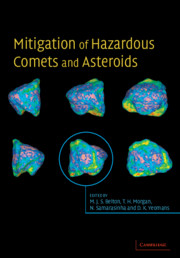Book contents
- Frontmatter
- Contents
- List of contributors
- Preface
- Acknowledgments
- Glossary
- 1 Recent progress in interpreting the nature of the near-Earth object population
- 2 Earth impactors: orbital characteristics and warning times
- 3 The role of radar in predicting and preventing asteroid and comet collisions with Earth
- 4 Interior structures for asteroids and cometary nuclei
- 5 What we know and don't know about surfaces of potentially hazardous small bodies
- 6 About deflecting asteroids and comets
- 7 Scientific requirements for understanding the near-Earth asteroid population
- 8 Physical properties of comets and asteroids inferred from fireball observations
- 9 Mitigation technologies and their requirements
- 10 Peering inside near-Earth objects with radio tomography
- 11 Seismological investigation of asteroid and comet interiors
- 12 Lander and penetrator science for near-Earth object mitigation studies
- 13 Optimal interception and deflection of Earth-approaching asteroids using low-thrust electric propulsion
- 14 Close proximity operations at small bodies: orbiting, hovering, and hopping
- 15 Mission operations in low-gravity regolith and dust
- 16 Impacts and the public: communicating the nature of the impact hazard
- 17 Towards a national program to remove the threat of hazardous NEOs
- Index
6 - About deflecting asteroids and comets
Published online by Cambridge University Press: 12 October 2009
- Frontmatter
- Contents
- List of contributors
- Preface
- Acknowledgments
- Glossary
- 1 Recent progress in interpreting the nature of the near-Earth object population
- 2 Earth impactors: orbital characteristics and warning times
- 3 The role of radar in predicting and preventing asteroid and comet collisions with Earth
- 4 Interior structures for asteroids and cometary nuclei
- 5 What we know and don't know about surfaces of potentially hazardous small bodies
- 6 About deflecting asteroids and comets
- 7 Scientific requirements for understanding the near-Earth asteroid population
- 8 Physical properties of comets and asteroids inferred from fireball observations
- 9 Mitigation technologies and their requirements
- 10 Peering inside near-Earth objects with radio tomography
- 11 Seismological investigation of asteroid and comet interiors
- 12 Lander and penetrator science for near-Earth object mitigation studies
- 13 Optimal interception and deflection of Earth-approaching asteroids using low-thrust electric propulsion
- 14 Close proximity operations at small bodies: orbiting, hovering, and hopping
- 15 Mission operations in low-gravity regolith and dust
- 16 Impacts and the public: communicating the nature of the impact hazard
- 17 Towards a national program to remove the threat of hazardous NEOs
- Index
Summary
Introduction
In the 1994 book edited by Gehrels, Hazards due to Comets and Asteroids, chapters by Ahrens and Harris (1994), Shafer et al. (1994), Simonenko et al. (1994), Solem and Snell (1994), and Melosh et al. (1994) present and study a number of ways of preventing an oncoming asteroid from colliding with the Earth. Most methods considered nudging it sufficiently at 10 or so years before the impending collision to change its course so it would miss the Earth.
The methods studied include the use of conventional or nuclear explosives on or below the surface, the impact by large masses at high velocities, the blowing off of material by standoff nuclear weapons or by the concentration of solar energy using giant mirrors or by zapping it with lasers, and more gentle methods such as simply attaching a propulsion rocket, a solar sail or launching surface material off at sufficient velocity to escape the asteroid.
The analyses of the different methods rely primarily on data and estimates accumulated for cratering and disruption using the material properties of terrestrial materials. In most cases those were silicate materials with mass densities of ∼3 g cm–3 or iron asteroids of density ∼8 g cm–3. However, it is becoming generally accepted that many of the asteroids are re-accumulated rubble pile bodies of very low density and strength, and comets have been thought for some time to have that structure.
- Type
- Chapter
- Information
- Mitigation of Hazardous Comets and Asteroids , pp. 113 - 140Publisher: Cambridge University PressPrint publication year: 2004
- 22
- Cited by

